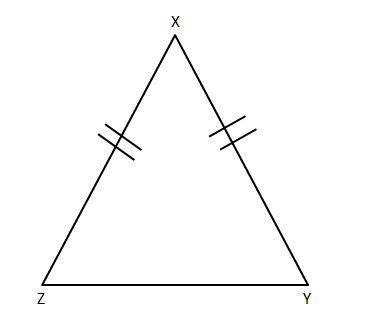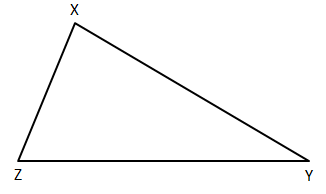
How are isosceles and scalene triangles different?
Answer
537.6k+ views
Hint: Here we have to discuss the isosceles and scalene triangles. First we defied them and compared to it as their difference. Finally we get the required answer.
Complete step by step answer:
We have to differentiate isosceles and scalene triangles.
Let us check the definition of isosceles and scalene triangles.
So, the basic difference of an isosceles and scalene triangle is their side.
Here, Isosceles triangle as follows:

Also, Scalene triangle as follows:

Hence we conclude the required answer.
Note: Scalene: from the Indo-European root skel- "to cut." Greek skalenos originally meant "stirred up, hoed up." When a piece of ground is stirred up, the surface becomes "uneven," which was a later meaning of skalenos. A scalene triangle is uneven in the sense that all three sides are of different lengths. The scalene muscles on each side of a person's neck are named for their triangular appearance. A scalene cone or cylinder is one whose axis is not perpendicular to its base; opposite elements make "uneven" angles with the base.
Isosceles: from Greek isos "equal", of unknown prior origin, and skelos "leg". The Indo-European root (s)kel- "curved, bent" is found in scoliosis and colon, borrowed from Greek. In geometry, an isosceles triangle or trapezoid has two equal legs. It may seem strange that the root means "bent" even though the sides of a triangle or trapezoid are straight, but each leg is bent relative to the adjoining legs.
Equilateral: from Latin æquus "even, level," and latus, stem later-, "side," both of uncertain origin. Related borrowings from Latin are bilateral and multilateral. In geometry, equilateral triangle is one in which all sides are equal in length.
Complete step by step answer:
We have to differentiate isosceles and scalene triangles.
Let us check the definition of isosceles and scalene triangles.
| Isosceles triangle | Scalene triangle |
| In an isosceles triangle, two sides are the same length. | In a scalene triangle, none of the sides are the same length. |
| An isosceles triangle may be right, obtuse, or acute. | A scalene triangle may be right, obtuse, or acute. |
| For isosceles triangle, two sides are equal | For scalene triangles no sides are equal. |
So, the basic difference of an isosceles and scalene triangle is their side.
Here, Isosceles triangle as follows:

Also, Scalene triangle as follows:

Hence we conclude the required answer.
Note: Scalene: from the Indo-European root skel- "to cut." Greek skalenos originally meant "stirred up, hoed up." When a piece of ground is stirred up, the surface becomes "uneven," which was a later meaning of skalenos. A scalene triangle is uneven in the sense that all three sides are of different lengths. The scalene muscles on each side of a person's neck are named for their triangular appearance. A scalene cone or cylinder is one whose axis is not perpendicular to its base; opposite elements make "uneven" angles with the base.
Isosceles: from Greek isos "equal", of unknown prior origin, and skelos "leg". The Indo-European root (s)kel- "curved, bent" is found in scoliosis and colon, borrowed from Greek. In geometry, an isosceles triangle or trapezoid has two equal legs. It may seem strange that the root means "bent" even though the sides of a triangle or trapezoid are straight, but each leg is bent relative to the adjoining legs.
Equilateral: from Latin æquus "even, level," and latus, stem later-, "side," both of uncertain origin. Related borrowings from Latin are bilateral and multilateral. In geometry, equilateral triangle is one in which all sides are equal in length.
Recently Updated Pages
Master Class 10 General Knowledge: Engaging Questions & Answers for Success

Master Class 10 Computer Science: Engaging Questions & Answers for Success

Master Class 10 English: Engaging Questions & Answers for Success

Master Class 10 Social Science: Engaging Questions & Answers for Success

Master Class 10 Maths: Engaging Questions & Answers for Success

Master Class 10 Science: Engaging Questions & Answers for Success

Trending doubts
The shortest day of the year in India

Why is there a time difference of about 5 hours between class 10 social science CBSE

Write a letter to the principal requesting him to grant class 10 english CBSE

What is the median of the first 10 natural numbers class 10 maths CBSE

The Equation xxx + 2 is Satisfied when x is Equal to Class 10 Maths

Which of the following does not have a fundamental class 10 physics CBSE




